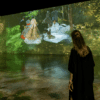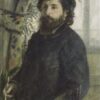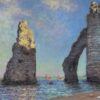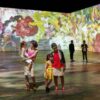
Claude Monet’s Artistic Inspiration: A Symphony of Nature and Emotion

Water Lilies and Japanese Bridge, Claude Monet (1840-1926) | Wiki Commons
Claude Monet, known as the Father of Impressionism, captivated the world with his breathtaking landscapes and enchanting scenes of nature. His artistic brilliance was fueled by a myriad of inspirations, ranging from the natural world to personal experiences, shaping his revolutionary approach to painting. Delving into Claude Monet’s artistic inspiration unveils a fascinating journey of creativity and innovation that continues to inspire generations of artists.
Nature as Inspiration
Monet’s deep connection with nature served as a profound source of inspiration throughout his career. He was entranced by the ever-changing beauty of the natural world, from the play of light on water to the vibrant colors of blooming flowers. Monet’s iconic series of paintings, such as “Water Lilies” and “Haystacks,” vividly capture the nuances of light and atmosphere, reflecting his relentless pursuit of capturing the ephemeral qualities of nature on canvas.
Moreover, Monet’s travels to various locales, including the picturesque landscapes of Normandy and the idyllic countryside of Giverny, provided endless inspiration for his artworks. The serene gardens and tranquil ponds of his residence in Giverny became a sanctuary for Monet, serving as both a source of solace and artistic inspiration. The iconic water garden at Giverny, with its iconic Japanese bridge and water lilies, served as the muse for some of Monet’s most celebrated works.

The water garden of Claude Monet in Giverny | Wiki Commons
Finding Creativity Through His Contemporaries
In addition to his love for nature, Monet drew inspiration from fellow artists and movements of his time. The camaraderie among the Impressionists, including artists like Renoir and Degas, fostered a spirit of experimentation and innovation. Monet’s interactions with his contemporaries influenced his artistic vision, encouraging him to push the boundaries of traditional painting techniques and embrace a more spontaneous and expressive style.
The Power of Air and Light
Furthermore, Monet’s fascination with capturing the fleeting effects of light and atmosphere led him to explore new artistic techniques, such as plein air painting. By painting outdoors directly from nature, Monet was able to immerse himself in the sensory experience of his surroundings, allowing him to infuse his artworks with a sense of immediacy and vitality.
Monet’s personal struggles and triumphs also played a significant role in shaping his artistic inspiration. From overcoming financial hardships to coping with personal losses, Monet’s resilience and determination fueled his artistic vision, allowing him to channel his emotions onto the canvas with unmatched intensity and passion.
An Artist Will Find Inspiration Anywhere
In conclusion, Claude Monet’s artistic inspiration was a rich tapestry woven from the beauty of nature, the camaraderie of fellow artists, and the depths of his own emotions. His revolutionary approach to painting, characterized by bold brushwork and vibrant colors, continues to inspire artists around the world. Through his timeless masterpieces, Monet invites us to see the world through his eyes – a world imbued with wonder, beauty, and endless possibility.
Resources to learn more
- “Claude Monet: Life and Artistic Legacy.” The Art Story, www.theartstory.org/artist/monet-claude/.
- Metropolitan Museum of Art. “Monet’s Passion for Water Lilies.” www.metmuseum.org/blogs/now-at-the-met/2018/monet-water-lilies.
- “Claude Monet (1840–1926).” The Metropolitan Museum of Art, www.metmuseum.org/toah/hd/cmon/hd_cmon.htm.
- National Gallery of Art. “Claude Monet: The Truth of Nature.” www.nga.gov/exhibitions/2019/monet-the-truth-of-nature.html.
Brush Up On Monet
Sign up for our newsletter and be the first to know about announcements in your area. As a subscriber, you will get exclusive presale access and discount offers.











































